Construction Materials: LCA, Timber Grading, Steel Corrosion Analysis
VerifiedAdded on 2020/03/16
|12
|2785
|225
Homework Assignment
AI Summary
This assignment delves into various aspects of construction materials, beginning with an overview of Life Cycle Assessment (LCA), its methodology, and its importance in evaluating the environmental impacts of products from raw material extraction to disposal. It then defines operational and embodied energy, highlighting the differences between energy consumption during production and application. The assignment also outlines the process of conducting an impact assessment, including the selection of impact categories, classification, and impact measurement, as well as the step-by-step procedure for conducting an LCA, from defining goals and scope to inventory analysis, life cycle impact assessment, and interpretation. Furthermore, it explores structural grading rules for Australian timber, differentiating between visual and machine stress grading, and explains the factors affecting brittle structures and corrosion in steel, along with methods to prevent corrosion. Finally, it touches upon the factors influencing fatigue life in materials.
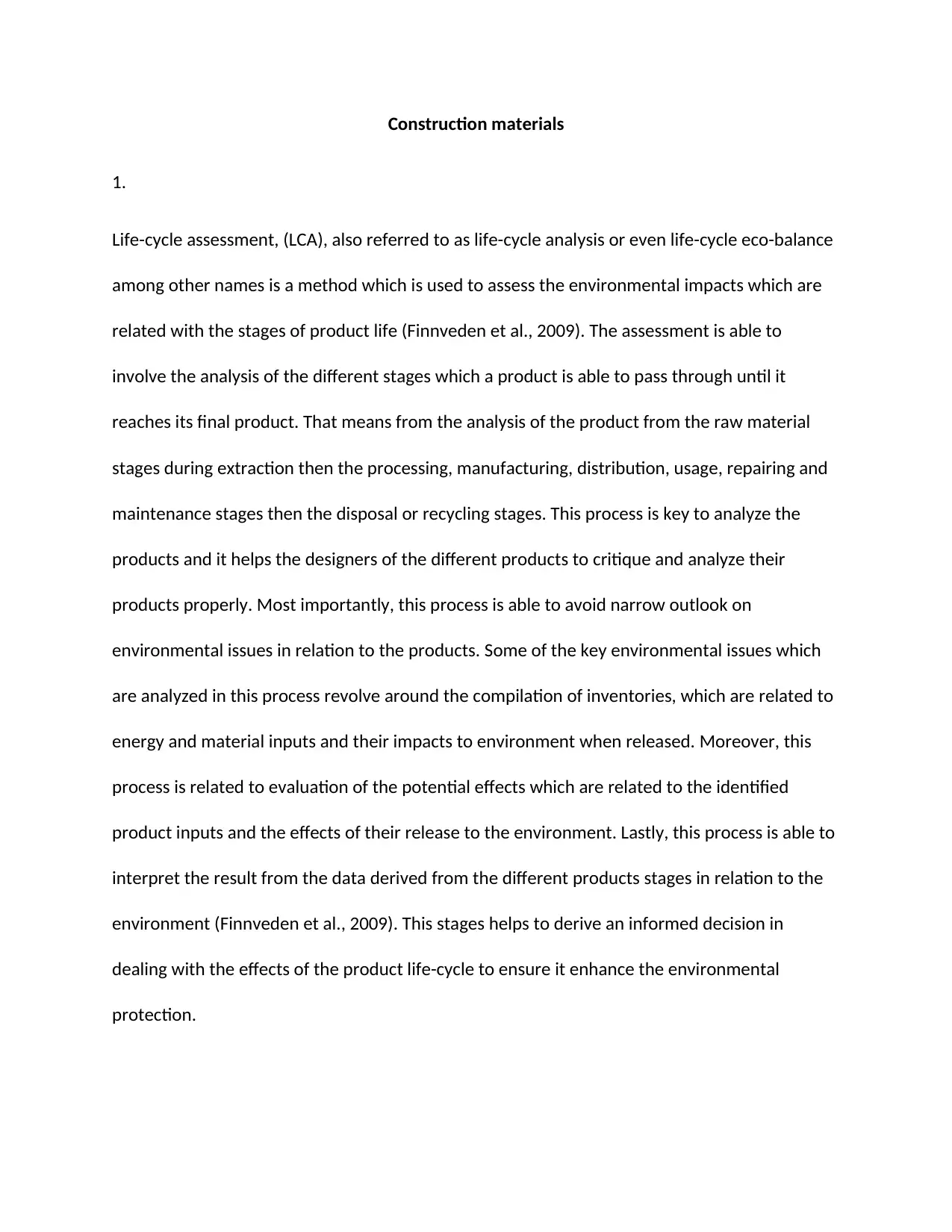
Construction materials
1.
Life-cycle assessment, (LCA), also referred to as life-cycle analysis or even life-cycle eco-balance
among other names is a method which is used to assess the environmental impacts which are
related with the stages of product life (Finnveden et al., 2009). The assessment is able to
involve the analysis of the different stages which a product is able to pass through until it
reaches its final product. That means from the analysis of the product from the raw material
stages during extraction then the processing, manufacturing, distribution, usage, repairing and
maintenance stages then the disposal or recycling stages. This process is key to analyze the
products and it helps the designers of the different products to critique and analyze their
products properly. Most importantly, this process is able to avoid narrow outlook on
environmental issues in relation to the products. Some of the key environmental issues which
are analyzed in this process revolve around the compilation of inventories, which are related to
energy and material inputs and their impacts to environment when released. Moreover, this
process is related to evaluation of the potential effects which are related to the identified
product inputs and the effects of their release to the environment. Lastly, this process is able to
interpret the result from the data derived from the different products stages in relation to the
environment (Finnveden et al., 2009). This stages helps to derive an informed decision in
dealing with the effects of the product life-cycle to ensure it enhance the environmental
protection.
1.
Life-cycle assessment, (LCA), also referred to as life-cycle analysis or even life-cycle eco-balance
among other names is a method which is used to assess the environmental impacts which are
related with the stages of product life (Finnveden et al., 2009). The assessment is able to
involve the analysis of the different stages which a product is able to pass through until it
reaches its final product. That means from the analysis of the product from the raw material
stages during extraction then the processing, manufacturing, distribution, usage, repairing and
maintenance stages then the disposal or recycling stages. This process is key to analyze the
products and it helps the designers of the different products to critique and analyze their
products properly. Most importantly, this process is able to avoid narrow outlook on
environmental issues in relation to the products. Some of the key environmental issues which
are analyzed in this process revolve around the compilation of inventories, which are related to
energy and material inputs and their impacts to environment when released. Moreover, this
process is related to evaluation of the potential effects which are related to the identified
product inputs and the effects of their release to the environment. Lastly, this process is able to
interpret the result from the data derived from the different products stages in relation to the
environment (Finnveden et al., 2009). This stages helps to derive an informed decision in
dealing with the effects of the product life-cycle to ensure it enhance the environmental
protection.
Paraphrase This Document
Need a fresh take? Get an instant paraphrase of this document with our AI Paraphraser
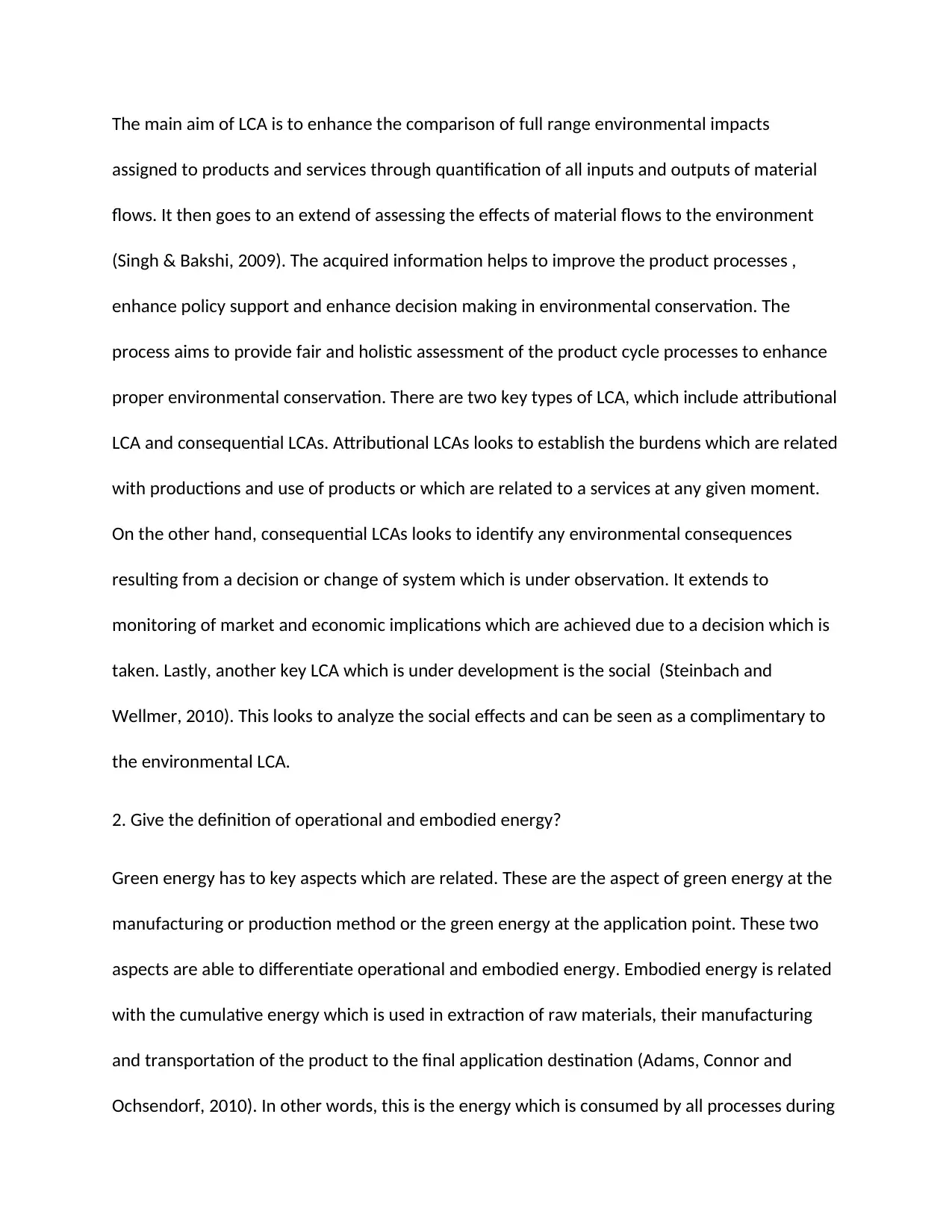
The main aim of LCA is to enhance the comparison of full range environmental impacts
assigned to products and services through quantification of all inputs and outputs of material
flows. It then goes to an extend of assessing the effects of material flows to the environment
(Singh & Bakshi, 2009). The acquired information helps to improve the product processes ,
enhance policy support and enhance decision making in environmental conservation. The
process aims to provide fair and holistic assessment of the product cycle processes to enhance
proper environmental conservation. There are two key types of LCA, which include attributional
LCA and consequential LCAs. Attributional LCAs looks to establish the burdens which are related
with productions and use of products or which are related to a services at any given moment.
On the other hand, consequential LCAs looks to identify any environmental consequences
resulting from a decision or change of system which is under observation. It extends to
monitoring of market and economic implications which are achieved due to a decision which is
taken. Lastly, another key LCA which is under development is the social (Steinbach and
Wellmer, 2010). This looks to analyze the social effects and can be seen as a complimentary to
the environmental LCA.
2. Give the definition of operational and embodied energy?
Green energy has to key aspects which are related. These are the aspect of green energy at the
manufacturing or production method or the green energy at the application point. These two
aspects are able to differentiate operational and embodied energy. Embodied energy is related
with the cumulative energy which is used in extraction of raw materials, their manufacturing
and transportation of the product to the final application destination (Adams, Connor and
Ochsendorf, 2010). In other words, this is the energy which is consumed by all processes during
assigned to products and services through quantification of all inputs and outputs of material
flows. It then goes to an extend of assessing the effects of material flows to the environment
(Singh & Bakshi, 2009). The acquired information helps to improve the product processes ,
enhance policy support and enhance decision making in environmental conservation. The
process aims to provide fair and holistic assessment of the product cycle processes to enhance
proper environmental conservation. There are two key types of LCA, which include attributional
LCA and consequential LCAs. Attributional LCAs looks to establish the burdens which are related
with productions and use of products or which are related to a services at any given moment.
On the other hand, consequential LCAs looks to identify any environmental consequences
resulting from a decision or change of system which is under observation. It extends to
monitoring of market and economic implications which are achieved due to a decision which is
taken. Lastly, another key LCA which is under development is the social (Steinbach and
Wellmer, 2010). This looks to analyze the social effects and can be seen as a complimentary to
the environmental LCA.
2. Give the definition of operational and embodied energy?
Green energy has to key aspects which are related. These are the aspect of green energy at the
manufacturing or production method or the green energy at the application point. These two
aspects are able to differentiate operational and embodied energy. Embodied energy is related
with the cumulative energy which is used in extraction of raw materials, their manufacturing
and transportation of the product to the final application destination (Adams, Connor and
Ochsendorf, 2010). In other words, this is the energy which is consumed by all processes during
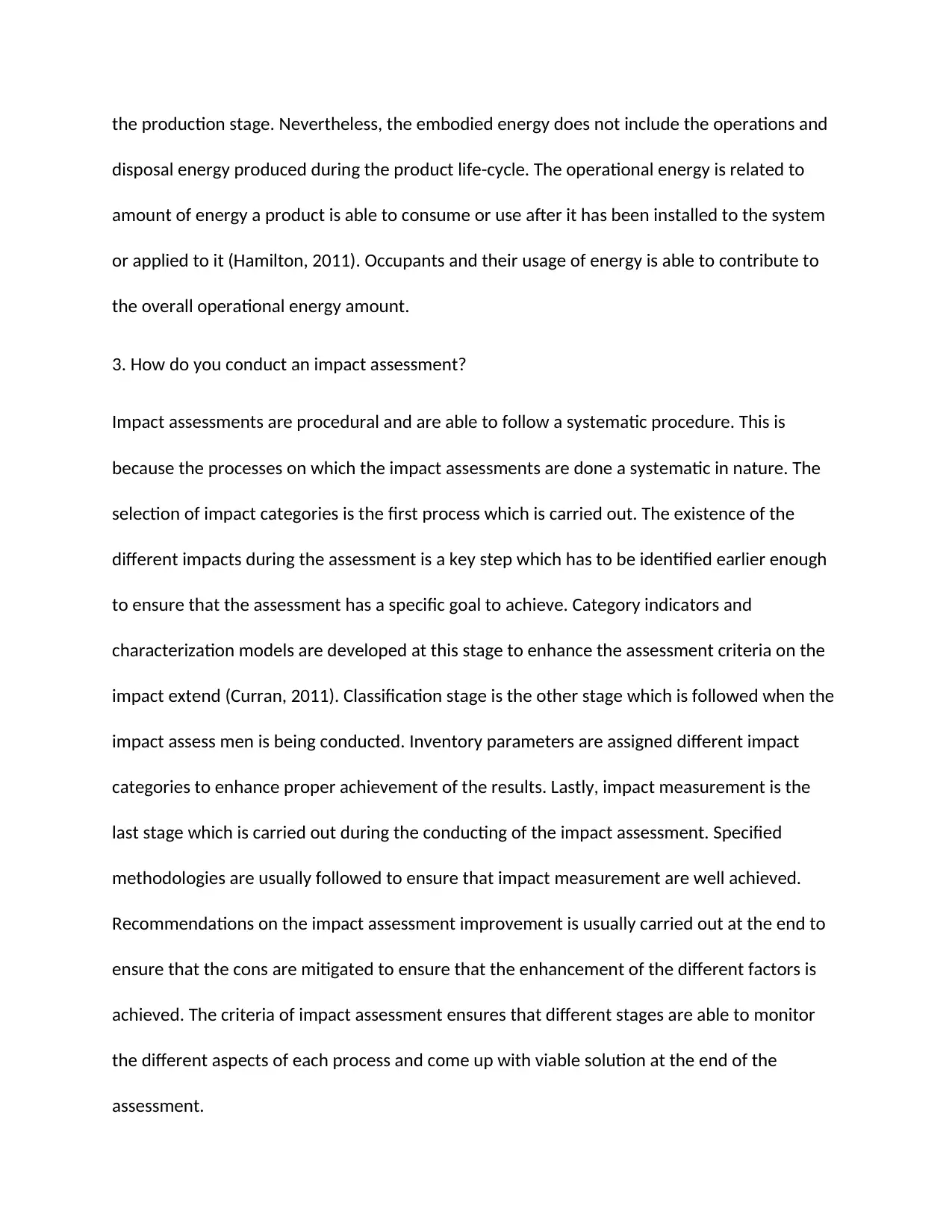
the production stage. Nevertheless, the embodied energy does not include the operations and
disposal energy produced during the product life-cycle. The operational energy is related to
amount of energy a product is able to consume or use after it has been installed to the system
or applied to it (Hamilton, 2011). Occupants and their usage of energy is able to contribute to
the overall operational energy amount.
3. How do you conduct an impact assessment?
Impact assessments are procedural and are able to follow a systematic procedure. This is
because the processes on which the impact assessments are done a systematic in nature. The
selection of impact categories is the first process which is carried out. The existence of the
different impacts during the assessment is a key step which has to be identified earlier enough
to ensure that the assessment has a specific goal to achieve. Category indicators and
characterization models are developed at this stage to enhance the assessment criteria on the
impact extend (Curran, 2011). Classification stage is the other stage which is followed when the
impact assess men is being conducted. Inventory parameters are assigned different impact
categories to enhance proper achievement of the results. Lastly, impact measurement is the
last stage which is carried out during the conducting of the impact assessment. Specified
methodologies are usually followed to ensure that impact measurement are well achieved.
Recommendations on the impact assessment improvement is usually carried out at the end to
ensure that the cons are mitigated to ensure that the enhancement of the different factors is
achieved. The criteria of impact assessment ensures that different stages are able to monitor
the different aspects of each process and come up with viable solution at the end of the
assessment.
disposal energy produced during the product life-cycle. The operational energy is related to
amount of energy a product is able to consume or use after it has been installed to the system
or applied to it (Hamilton, 2011). Occupants and their usage of energy is able to contribute to
the overall operational energy amount.
3. How do you conduct an impact assessment?
Impact assessments are procedural and are able to follow a systematic procedure. This is
because the processes on which the impact assessments are done a systematic in nature. The
selection of impact categories is the first process which is carried out. The existence of the
different impacts during the assessment is a key step which has to be identified earlier enough
to ensure that the assessment has a specific goal to achieve. Category indicators and
characterization models are developed at this stage to enhance the assessment criteria on the
impact extend (Curran, 2011). Classification stage is the other stage which is followed when the
impact assess men is being conducted. Inventory parameters are assigned different impact
categories to enhance proper achievement of the results. Lastly, impact measurement is the
last stage which is carried out during the conducting of the impact assessment. Specified
methodologies are usually followed to ensure that impact measurement are well achieved.
Recommendations on the impact assessment improvement is usually carried out at the end to
ensure that the cons are mitigated to ensure that the enhancement of the different factors is
achieved. The criteria of impact assessment ensures that different stages are able to monitor
the different aspects of each process and come up with viable solution at the end of the
assessment.
⊘ This is a preview!⊘
Do you want full access?
Subscribe today to unlock all pages.

Trusted by 1+ million students worldwide
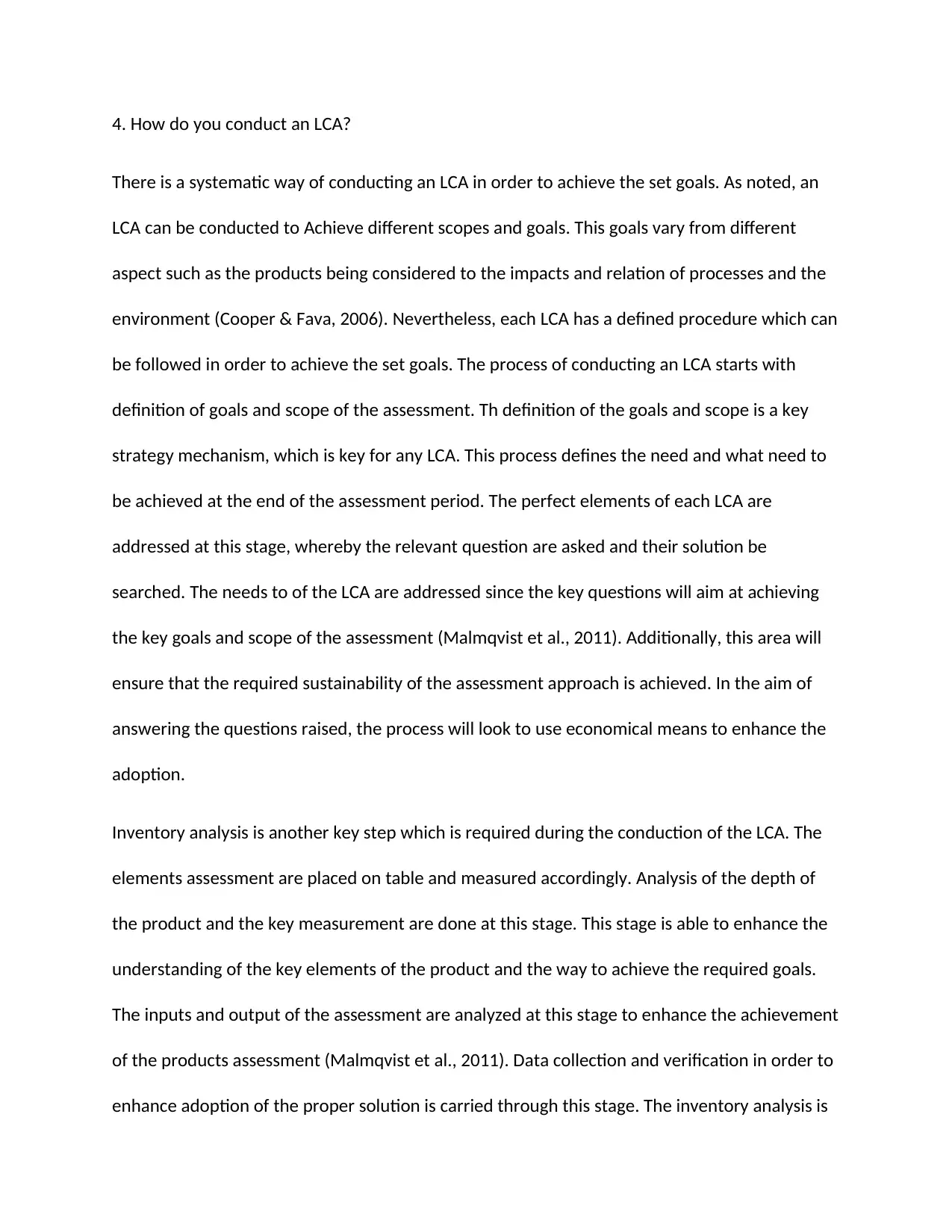
4. How do you conduct an LCA?
There is a systematic way of conducting an LCA in order to achieve the set goals. As noted, an
LCA can be conducted to Achieve different scopes and goals. This goals vary from different
aspect such as the products being considered to the impacts and relation of processes and the
environment (Cooper & Fava, 2006). Nevertheless, each LCA has a defined procedure which can
be followed in order to achieve the set goals. The process of conducting an LCA starts with
definition of goals and scope of the assessment. Th definition of the goals and scope is a key
strategy mechanism, which is key for any LCA. This process defines the need and what need to
be achieved at the end of the assessment period. The perfect elements of each LCA are
addressed at this stage, whereby the relevant question are asked and their solution be
searched. The needs to of the LCA are addressed since the key questions will aim at achieving
the key goals and scope of the assessment (Malmqvist et al., 2011). Additionally, this area will
ensure that the required sustainability of the assessment approach is achieved. In the aim of
answering the questions raised, the process will look to use economical means to enhance the
adoption.
Inventory analysis is another key step which is required during the conduction of the LCA. The
elements assessment are placed on table and measured accordingly. Analysis of the depth of
the product and the key measurement are done at this stage. This stage is able to enhance the
understanding of the key elements of the product and the way to achieve the required goals.
The inputs and output of the assessment are analyzed at this stage to enhance the achievement
of the products assessment (Malmqvist et al., 2011). Data collection and verification in order to
enhance adoption of the proper solution is carried through this stage. The inventory analysis is
There is a systematic way of conducting an LCA in order to achieve the set goals. As noted, an
LCA can be conducted to Achieve different scopes and goals. This goals vary from different
aspect such as the products being considered to the impacts and relation of processes and the
environment (Cooper & Fava, 2006). Nevertheless, each LCA has a defined procedure which can
be followed in order to achieve the set goals. The process of conducting an LCA starts with
definition of goals and scope of the assessment. Th definition of the goals and scope is a key
strategy mechanism, which is key for any LCA. This process defines the need and what need to
be achieved at the end of the assessment period. The perfect elements of each LCA are
addressed at this stage, whereby the relevant question are asked and their solution be
searched. The needs to of the LCA are addressed since the key questions will aim at achieving
the key goals and scope of the assessment (Malmqvist et al., 2011). Additionally, this area will
ensure that the required sustainability of the assessment approach is achieved. In the aim of
answering the questions raised, the process will look to use economical means to enhance the
adoption.
Inventory analysis is another key step which is required during the conduction of the LCA. The
elements assessment are placed on table and measured accordingly. Analysis of the depth of
the product and the key measurement are done at this stage. This stage is able to enhance the
understanding of the key elements of the product and the way to achieve the required goals.
The inputs and output of the assessment are analyzed at this stage to enhance the achievement
of the products assessment (Malmqvist et al., 2011). Data collection and verification in order to
enhance adoption of the proper solution is carried through this stage. The inventory analysis is
Paraphrase This Document
Need a fresh take? Get an instant paraphrase of this document with our AI Paraphraser
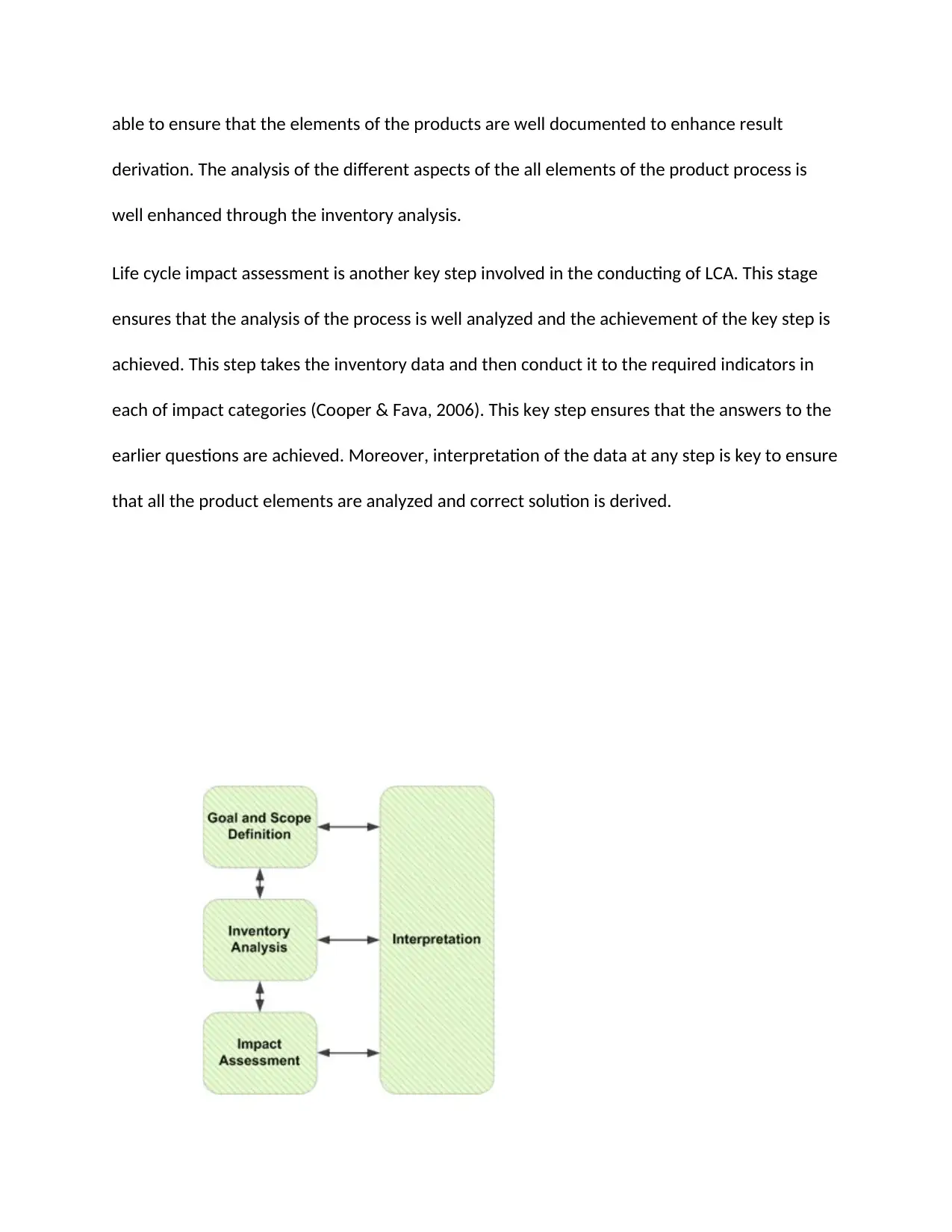
able to ensure that the elements of the products are well documented to enhance result
derivation. The analysis of the different aspects of the all elements of the product process is
well enhanced through the inventory analysis.
Life cycle impact assessment is another key step involved in the conducting of LCA. This stage
ensures that the analysis of the process is well analyzed and the achievement of the key step is
achieved. This step takes the inventory data and then conduct it to the required indicators in
each of impact categories (Cooper & Fava, 2006). This key step ensures that the answers to the
earlier questions are achieved. Moreover, interpretation of the data at any step is key to ensure
that all the product elements are analyzed and correct solution is derived.
derivation. The analysis of the different aspects of the all elements of the product process is
well enhanced through the inventory analysis.
Life cycle impact assessment is another key step involved in the conducting of LCA. This stage
ensures that the analysis of the process is well analyzed and the achievement of the key step is
achieved. This step takes the inventory data and then conduct it to the required indicators in
each of impact categories (Cooper & Fava, 2006). This key step ensures that the answers to the
earlier questions are achieved. Moreover, interpretation of the data at any step is key to ensure
that all the product elements are analyzed and correct solution is derived.
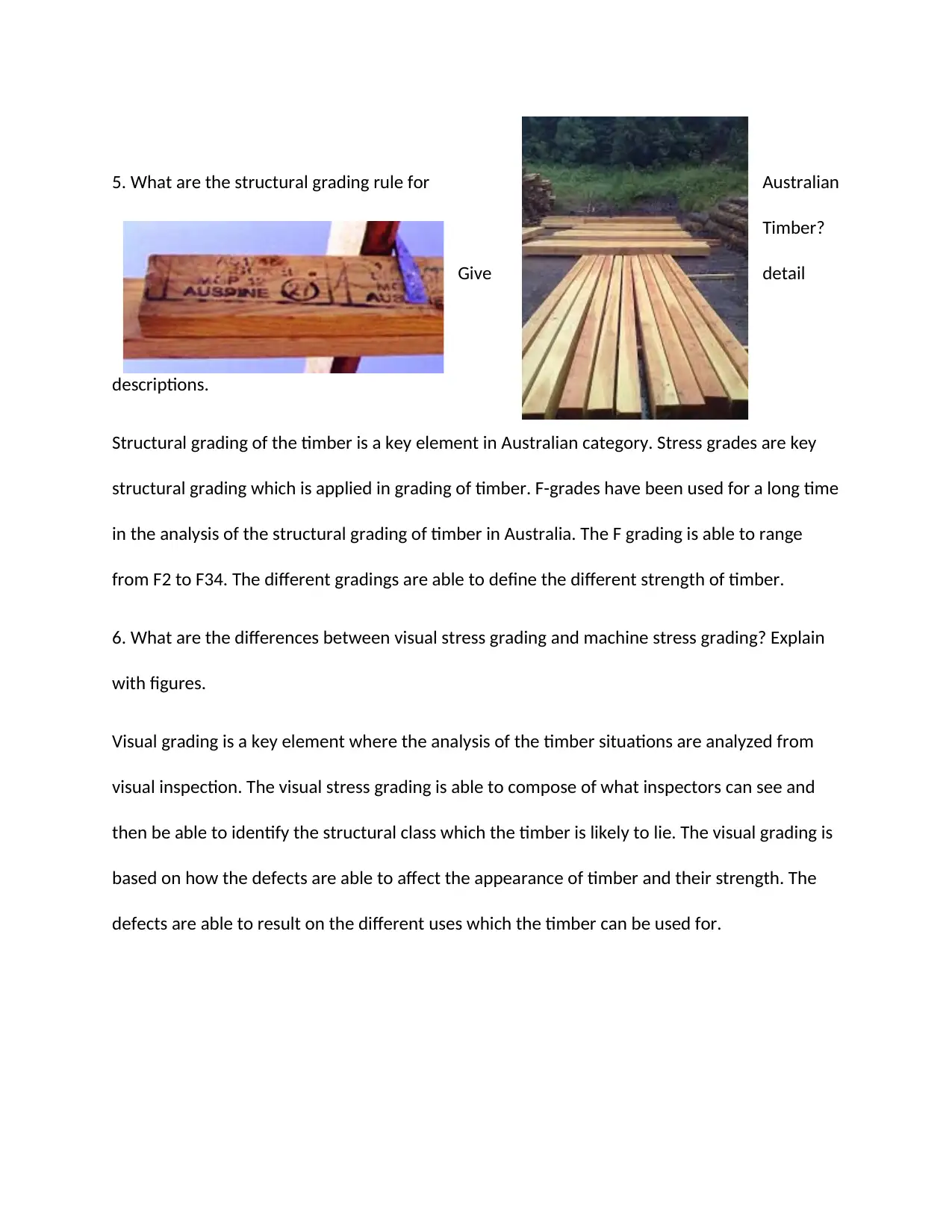
5. What are the structural grading rule for Australian
Timber?
Give detail
descriptions.
Structural grading of the timber is a key element in Australian category. Stress grades are key
structural grading which is applied in grading of timber. F-grades have been used for a long time
in the analysis of the structural grading of timber in Australia. The F grading is able to range
from F2 to F34. The different gradings are able to define the different strength of timber.
6. What are the differences between visual stress grading and machine stress grading? Explain
with figures.
Visual grading is a key element where the analysis of the timber situations are analyzed from
visual inspection. The visual stress grading is able to compose of what inspectors can see and
then be able to identify the structural class which the timber is likely to lie. The visual grading is
based on how the defects are able to affect the appearance of timber and their strength. The
defects are able to result on the different uses which the timber can be used for.
Timber?
Give detail
descriptions.
Structural grading of the timber is a key element in Australian category. Stress grades are key
structural grading which is applied in grading of timber. F-grades have been used for a long time
in the analysis of the structural grading of timber in Australia. The F grading is able to range
from F2 to F34. The different gradings are able to define the different strength of timber.
6. What are the differences between visual stress grading and machine stress grading? Explain
with figures.
Visual grading is a key element where the analysis of the timber situations are analyzed from
visual inspection. The visual stress grading is able to compose of what inspectors can see and
then be able to identify the structural class which the timber is likely to lie. The visual grading is
based on how the defects are able to affect the appearance of timber and their strength. The
defects are able to result on the different uses which the timber can be used for.
⊘ This is a preview!⊘
Do you want full access?
Subscribe today to unlock all pages.

Trusted by 1+ million students worldwide
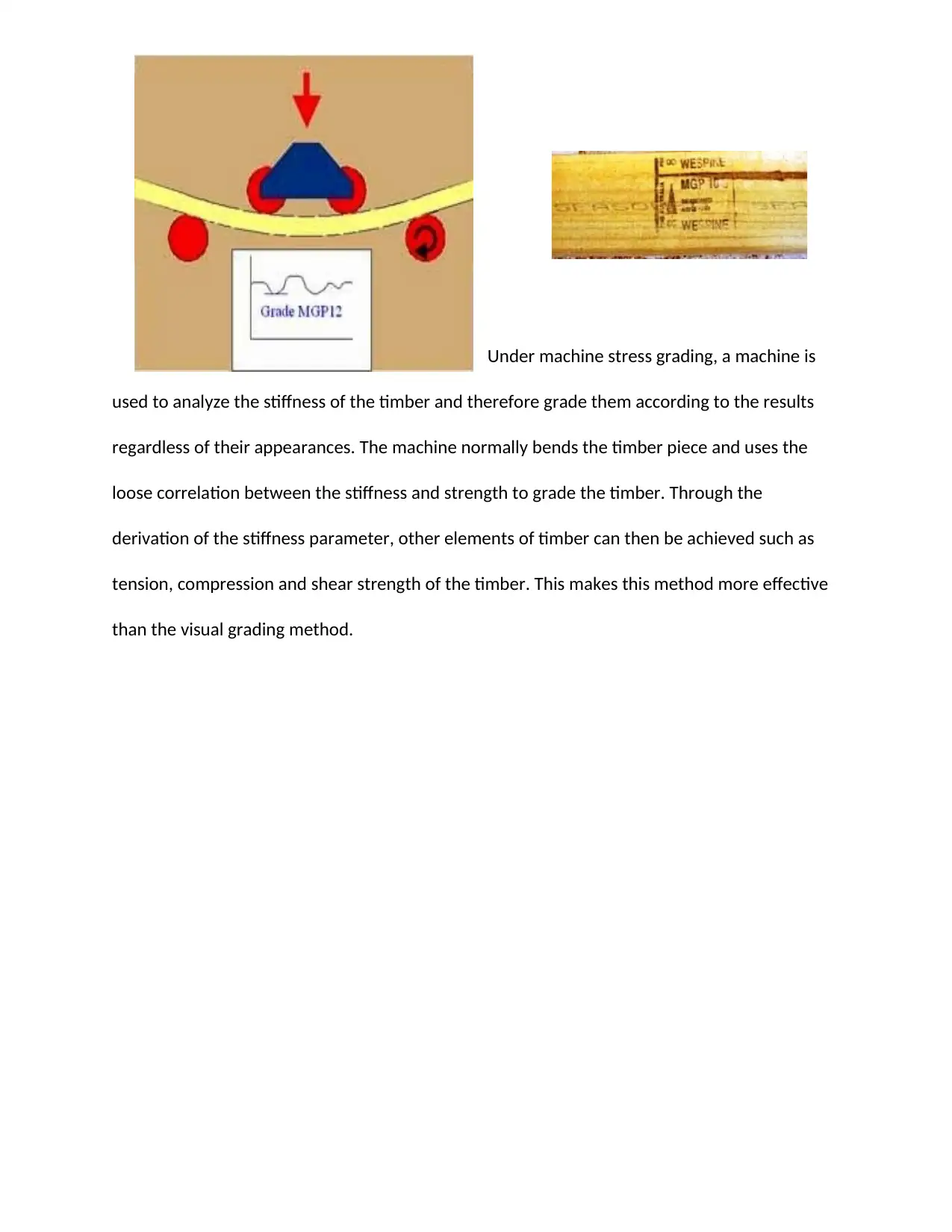
Under machine stress grading, a machine is
used to analyze the stiffness of the timber and therefore grade them according to the results
regardless of their appearances. The machine normally bends the timber piece and uses the
loose correlation between the stiffness and strength to grade the timber. Through the
derivation of the stiffness parameter, other elements of timber can then be achieved such as
tension, compression and shear strength of the timber. This makes this method more effective
than the visual grading method.
used to analyze the stiffness of the timber and therefore grade them according to the results
regardless of their appearances. The machine normally bends the timber piece and uses the
loose correlation between the stiffness and strength to grade the timber. Through the
derivation of the stiffness parameter, other elements of timber can then be achieved such as
tension, compression and shear strength of the timber. This makes this method more effective
than the visual grading method.
Paraphrase This Document
Need a fresh take? Get an instant paraphrase of this document with our AI Paraphraser
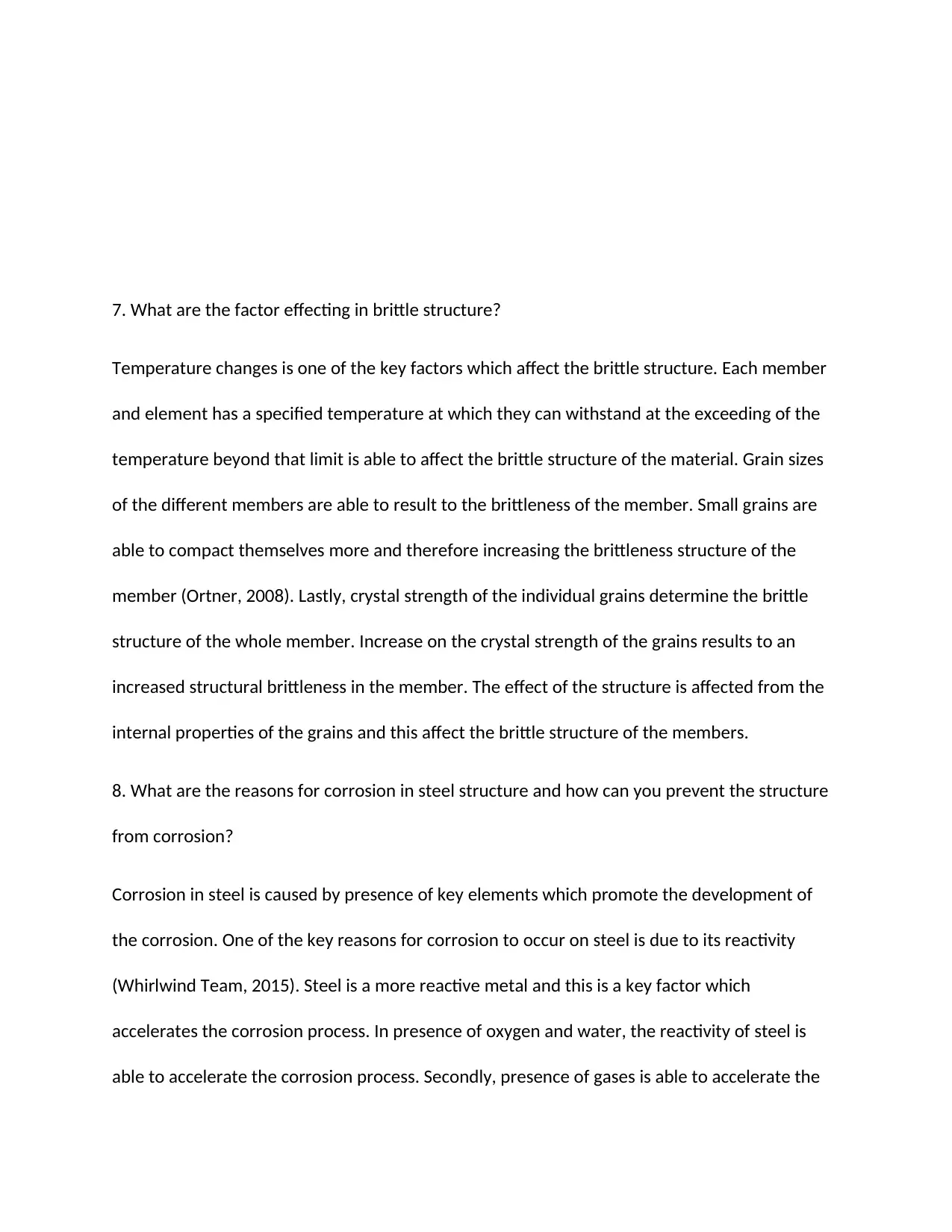
7. What are the factor effecting in brittle structure?
Temperature changes is one of the key factors which affect the brittle structure. Each member
and element has a specified temperature at which they can withstand at the exceeding of the
temperature beyond that limit is able to affect the brittle structure of the material. Grain sizes
of the different members are able to result to the brittleness of the member. Small grains are
able to compact themselves more and therefore increasing the brittleness structure of the
member (Ortner, 2008). Lastly, crystal strength of the individual grains determine the brittle
structure of the whole member. Increase on the crystal strength of the grains results to an
increased structural brittleness in the member. The effect of the structure is affected from the
internal properties of the grains and this affect the brittle structure of the members.
8. What are the reasons for corrosion in steel structure and how can you prevent the structure
from corrosion?
Corrosion in steel is caused by presence of key elements which promote the development of
the corrosion. One of the key reasons for corrosion to occur on steel is due to its reactivity
(Whirlwind Team, 2015). Steel is a more reactive metal and this is a key factor which
accelerates the corrosion process. In presence of oxygen and water, the reactivity of steel is
able to accelerate the corrosion process. Secondly, presence of gases is able to accelerate the
Temperature changes is one of the key factors which affect the brittle structure. Each member
and element has a specified temperature at which they can withstand at the exceeding of the
temperature beyond that limit is able to affect the brittle structure of the material. Grain sizes
of the different members are able to result to the brittleness of the member. Small grains are
able to compact themselves more and therefore increasing the brittleness structure of the
member (Ortner, 2008). Lastly, crystal strength of the individual grains determine the brittle
structure of the whole member. Increase on the crystal strength of the grains results to an
increased structural brittleness in the member. The effect of the structure is affected from the
internal properties of the grains and this affect the brittle structure of the members.
8. What are the reasons for corrosion in steel structure and how can you prevent the structure
from corrosion?
Corrosion in steel is caused by presence of key elements which promote the development of
the corrosion. One of the key reasons for corrosion to occur on steel is due to its reactivity
(Whirlwind Team, 2015). Steel is a more reactive metal and this is a key factor which
accelerates the corrosion process. In presence of oxygen and water, the reactivity of steel is
able to accelerate the corrosion process. Secondly, presence of gases is able to accelerate the
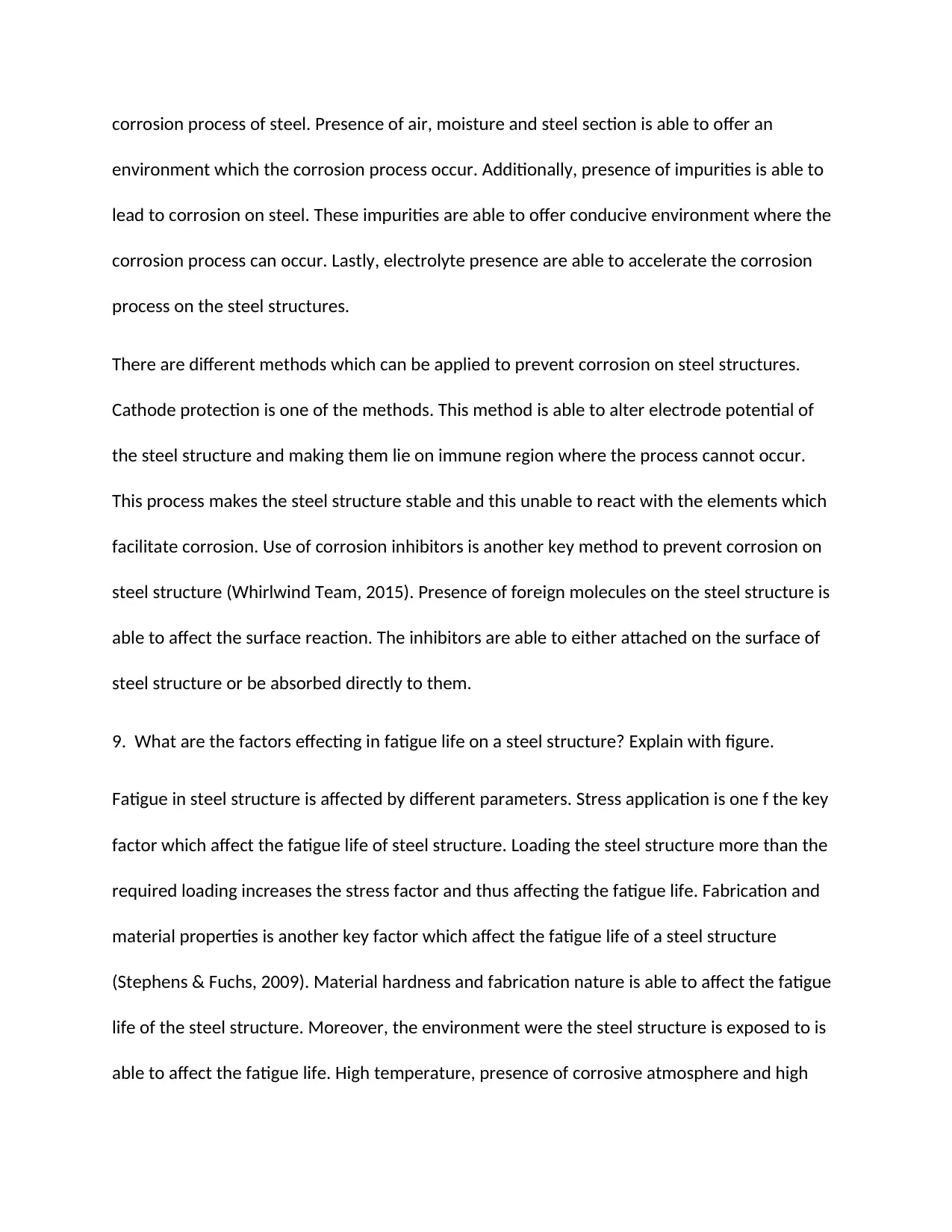
corrosion process of steel. Presence of air, moisture and steel section is able to offer an
environment which the corrosion process occur. Additionally, presence of impurities is able to
lead to corrosion on steel. These impurities are able to offer conducive environment where the
corrosion process can occur. Lastly, electrolyte presence are able to accelerate the corrosion
process on the steel structures.
There are different methods which can be applied to prevent corrosion on steel structures.
Cathode protection is one of the methods. This method is able to alter electrode potential of
the steel structure and making them lie on immune region where the process cannot occur.
This process makes the steel structure stable and this unable to react with the elements which
facilitate corrosion. Use of corrosion inhibitors is another key method to prevent corrosion on
steel structure (Whirlwind Team, 2015). Presence of foreign molecules on the steel structure is
able to affect the surface reaction. The inhibitors are able to either attached on the surface of
steel structure or be absorbed directly to them.
9. What are the factors effecting in fatigue life on a steel structure? Explain with figure.
Fatigue in steel structure is affected by different parameters. Stress application is one f the key
factor which affect the fatigue life of steel structure. Loading the steel structure more than the
required loading increases the stress factor and thus affecting the fatigue life. Fabrication and
material properties is another key factor which affect the fatigue life of a steel structure
(Stephens & Fuchs, 2009). Material hardness and fabrication nature is able to affect the fatigue
life of the steel structure. Moreover, the environment were the steel structure is exposed to is
able to affect the fatigue life. High temperature, presence of corrosive atmosphere and high
environment which the corrosion process occur. Additionally, presence of impurities is able to
lead to corrosion on steel. These impurities are able to offer conducive environment where the
corrosion process can occur. Lastly, electrolyte presence are able to accelerate the corrosion
process on the steel structures.
There are different methods which can be applied to prevent corrosion on steel structures.
Cathode protection is one of the methods. This method is able to alter electrode potential of
the steel structure and making them lie on immune region where the process cannot occur.
This process makes the steel structure stable and this unable to react with the elements which
facilitate corrosion. Use of corrosion inhibitors is another key method to prevent corrosion on
steel structure (Whirlwind Team, 2015). Presence of foreign molecules on the steel structure is
able to affect the surface reaction. The inhibitors are able to either attached on the surface of
steel structure or be absorbed directly to them.
9. What are the factors effecting in fatigue life on a steel structure? Explain with figure.
Fatigue in steel structure is affected by different parameters. Stress application is one f the key
factor which affect the fatigue life of steel structure. Loading the steel structure more than the
required loading increases the stress factor and thus affecting the fatigue life. Fabrication and
material properties is another key factor which affect the fatigue life of a steel structure
(Stephens & Fuchs, 2009). Material hardness and fabrication nature is able to affect the fatigue
life of the steel structure. Moreover, the environment were the steel structure is exposed to is
able to affect the fatigue life. High temperature, presence of corrosive atmosphere and high
⊘ This is a preview!⊘
Do you want full access?
Subscribe today to unlock all pages.

Trusted by 1+ million students worldwide
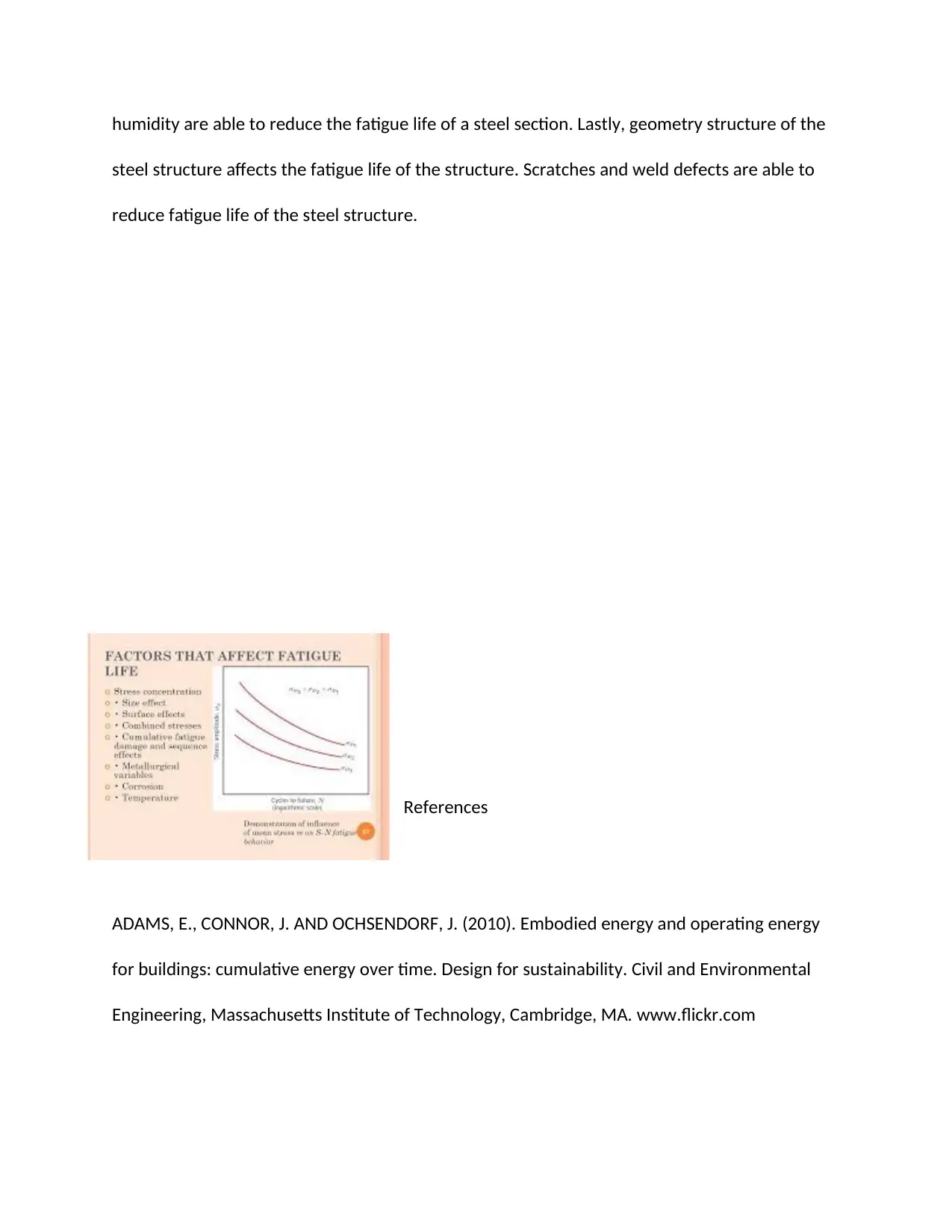
humidity are able to reduce the fatigue life of a steel section. Lastly, geometry structure of the
steel structure affects the fatigue life of the structure. Scratches and weld defects are able to
reduce fatigue life of the steel structure.
References
ADAMS, E., CONNOR, J. AND OCHSENDORF, J. (2010). Embodied energy and operating energy
for buildings: cumulative energy over time. Design for sustainability. Civil and Environmental
Engineering, Massachusetts Institute of Technology, Cambridge, MA. www.flickr.com
steel structure affects the fatigue life of the structure. Scratches and weld defects are able to
reduce fatigue life of the steel structure.
References
ADAMS, E., CONNOR, J. AND OCHSENDORF, J. (2010). Embodied energy and operating energy
for buildings: cumulative energy over time. Design for sustainability. Civil and Environmental
Engineering, Massachusetts Institute of Technology, Cambridge, MA. www.flickr.com
Paraphrase This Document
Need a fresh take? Get an instant paraphrase of this document with our AI Paraphraser
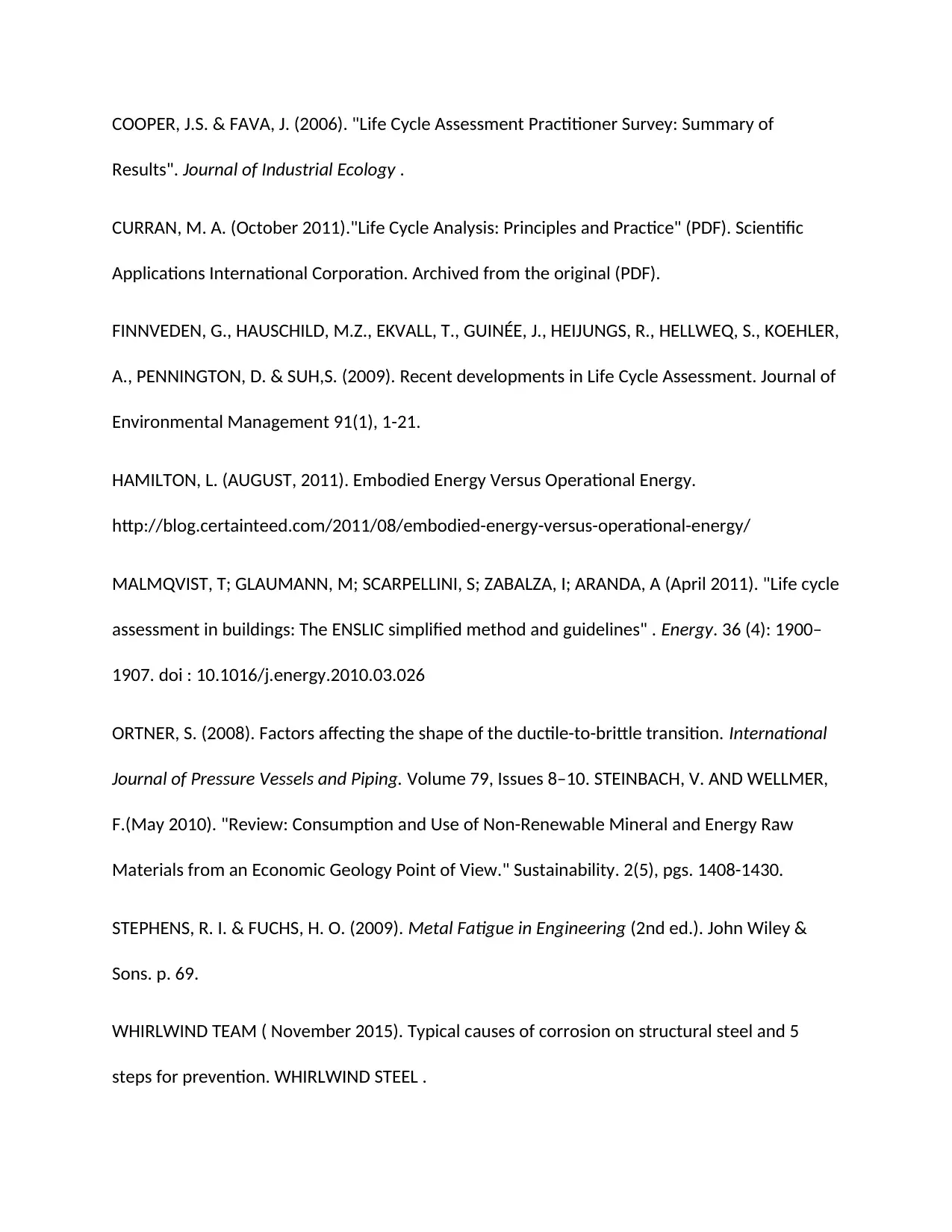
COOPER, J.S. & FAVA, J. (2006). "Life Cycle Assessment Practitioner Survey: Summary of
Results". Journal of Industrial Ecology .
CURRAN, M. A. (October 2011)."Life Cycle Analysis: Principles and Practice" (PDF). Scientific
Applications International Corporation. Archived from the original (PDF).
FINNVEDEN, G., HAUSCHILD, M.Z., EKVALL, T., GUINÉE, J., HEIJUNGS, R., HELLWEQ, S., KOEHLER,
A., PENNINGTON, D. & SUH,S. (2009). Recent developments in Life Cycle Assessment. Journal of
Environmental Management 91(1), 1-21.
HAMILTON, L. (AUGUST, 2011). Embodied Energy Versus Operational Energy.
http://blog.certainteed.com/2011/08/embodied-energy-versus-operational-energy/
MALMQVIST, T; GLAUMANN, M; SCARPELLINI, S; ZABALZA, I; ARANDA, A (April 2011). "Life cycle
assessment in buildings: The ENSLIC simplified method and guidelines" . Energy. 36 (4): 1900–
1907. doi : 10.1016/j.energy.2010.03.026
ORTNER, S. (2008). Factors affecting the shape of the ductile-to-brittle transition. International
Journal of Pressure Vessels and Piping. Volume 79, Issues 8–10. STEINBACH, V. AND WELLMER,
F.(May 2010). "Review: Consumption and Use of Non-Renewable Mineral and Energy Raw
Materials from an Economic Geology Point of View." Sustainability. 2(5), pgs. 1408-1430.
STEPHENS, R. I. & FUCHS, H. O. (2009). Metal Fatigue in Engineering (2nd ed.). John Wiley &
Sons. p. 69.
WHIRLWIND TEAM ( November 2015). Typical causes of corrosion on structural steel and 5
steps for prevention. WHIRLWIND STEEL .
Results". Journal of Industrial Ecology .
CURRAN, M. A. (October 2011)."Life Cycle Analysis: Principles and Practice" (PDF). Scientific
Applications International Corporation. Archived from the original (PDF).
FINNVEDEN, G., HAUSCHILD, M.Z., EKVALL, T., GUINÉE, J., HEIJUNGS, R., HELLWEQ, S., KOEHLER,
A., PENNINGTON, D. & SUH,S. (2009). Recent developments in Life Cycle Assessment. Journal of
Environmental Management 91(1), 1-21.
HAMILTON, L. (AUGUST, 2011). Embodied Energy Versus Operational Energy.
http://blog.certainteed.com/2011/08/embodied-energy-versus-operational-energy/
MALMQVIST, T; GLAUMANN, M; SCARPELLINI, S; ZABALZA, I; ARANDA, A (April 2011). "Life cycle
assessment in buildings: The ENSLIC simplified method and guidelines" . Energy. 36 (4): 1900–
1907. doi : 10.1016/j.energy.2010.03.026
ORTNER, S. (2008). Factors affecting the shape of the ductile-to-brittle transition. International
Journal of Pressure Vessels and Piping. Volume 79, Issues 8–10. STEINBACH, V. AND WELLMER,
F.(May 2010). "Review: Consumption and Use of Non-Renewable Mineral and Energy Raw
Materials from an Economic Geology Point of View." Sustainability. 2(5), pgs. 1408-1430.
STEPHENS, R. I. & FUCHS, H. O. (2009). Metal Fatigue in Engineering (2nd ed.). John Wiley &
Sons. p. 69.
WHIRLWIND TEAM ( November 2015). Typical causes of corrosion on structural steel and 5
steps for prevention. WHIRLWIND STEEL .
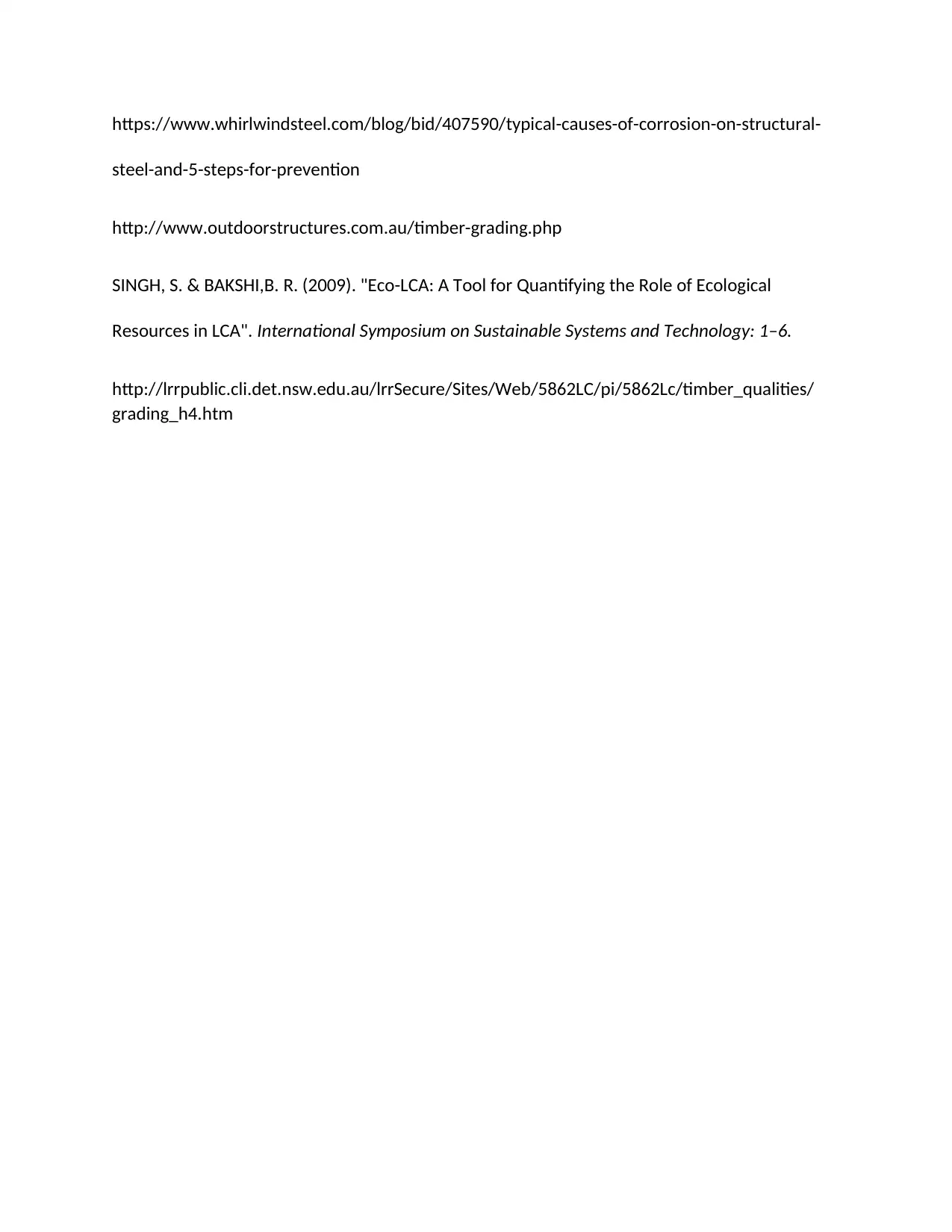
https://www.whirlwindsteel.com/blog/bid/407590/typical-causes-of-corrosion-on-structural-
steel-and-5-steps-for-prevention
http://www.outdoorstructures.com.au/timber-grading.php
SINGH, S. & BAKSHI,B. R. (2009). "Eco-LCA: A Tool for Quantifying the Role of Ecological
Resources in LCA". International Symposium on Sustainable Systems and Technology: 1–6.
http://lrrpublic.cli.det.nsw.edu.au/lrrSecure/Sites/Web/5862LC/pi/5862Lc/timber_qualities/
grading_h4.htm
steel-and-5-steps-for-prevention
http://www.outdoorstructures.com.au/timber-grading.php
SINGH, S. & BAKSHI,B. R. (2009). "Eco-LCA: A Tool for Quantifying the Role of Ecological
Resources in LCA". International Symposium on Sustainable Systems and Technology: 1–6.
http://lrrpublic.cli.det.nsw.edu.au/lrrSecure/Sites/Web/5862LC/pi/5862Lc/timber_qualities/
grading_h4.htm
⊘ This is a preview!⊘
Do you want full access?
Subscribe today to unlock all pages.

Trusted by 1+ million students worldwide
1 out of 12
Related Documents
Your All-in-One AI-Powered Toolkit for Academic Success.
+13062052269
info@desklib.com
Available 24*7 on WhatsApp / Email
![[object Object]](/_next/static/media/star-bottom.7253800d.svg)
Unlock your academic potential
Copyright © 2020–2025 A2Z Services. All Rights Reserved. Developed and managed by ZUCOL.





